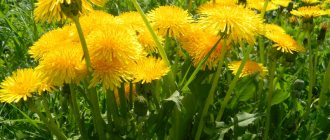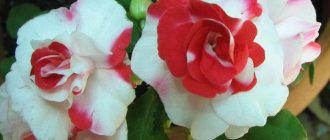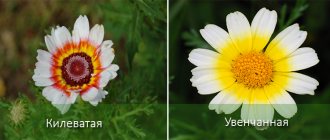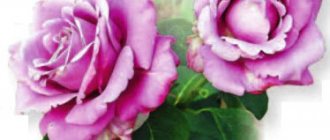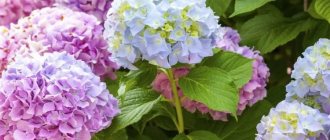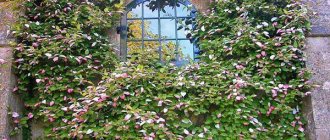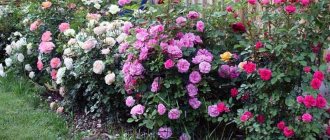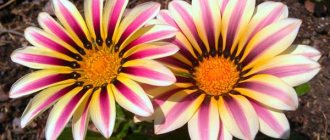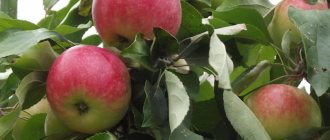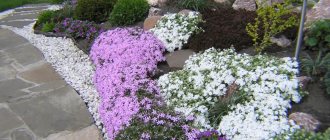Assigning colors for borders
In the garden, you often have to emphasize the regular or bizarre shape of a flower bed, edging, or surround a tree on the lawn. For edges and borders in the garden, low plants are usually chosen that will not hide greenery planted in the background or permanent architectural elements of the garden. They should have a compact shape and thicken well - then the borders look most impressive and create geometric (or irregular) patterns.
The list of border types of garden flowers suitable for use in our climate is very large - so it is easy to choose greenery for a specific garden style. The most commonly used:
- low-growing annuals;
- ground cover biennial plants;
- perennials;
- bushes.
Attention! In places where children often visit, it is better to plant greens that are resistant to trampling and mechanical damage. Such sensitive boundary areas are often found along paths, lawns, and playgrounds.
Plants are planted for lining various places:
- on the outskirts of flower beds;
- along rows of other flowers;
- along the paths;
- along curbs;
- wherever you need to mark a line.
It is better to choose flowers with a long flowering period.
You can also read: low-growing flowers that bloom all summer.
Such plants are used mainly for gardening, planting in balcony boxes and containers.
In the world of annuals, biennials, perennials and shrubs, there are many options suitable for forming decorative green or flowering borders. When choosing an option for the garden, you need to remember the basic rule - the borders must be dense so that they immediately give the desired effect. The plants are planted side by side so as not to wait for the planting to be compacted, because the idea of the border is precisely this uniform appearance, without breaks or wilted specimens. The curb should be visible from a distance.
When choosing plants for mini hedges, consider position, soil type and soil reaction. It is also important in which area the flowering borders are planted so that the garden blends in and harmonizes with its surroundings.
Low-growing annual and biennial flowers
Let's consider the best and most popular plants with a short lifespan - 1-2 years.
Annuals
Annuals require more care than perennials, but include many beautiful species that can be rotated each year.
Advantages:
- low purchase cost - in the case where there are a lot of borders - this is important;
- colorful flower beds;
- long flowering, right up to frost;
- Sowing new annuals every year makes the garden different every season.
The disadvantage of annuals is the high labor intensity of sowing, picking, and planting.
A convenient choice is seeds that can be sown directly into the ground - Marigolds, Lobularia marine, Marigolds. This will make the care work easier, because growing seedlings, picking and then replanting them in permanent places takes a lot of time.
You can grow seedlings from seedlings yourself. The first sowing begins in January and requires compliance with growing conditions. You can purchase ready-made seedlings. Of course, your own product will be cheaper, but you need to be patient and be willing to do the extra work.
Examples of annuals
| Name | Photo |
| Alyssum or allisum (Lobularia) | |
| Purslane (Portulaca) | |
| Dwarf nasturtium (Tropaeolum) | |
| Callistephus chinensis or aster (Callistephus) | |
| Zinnia |
The most commonly used annuals that bloom for a long time until frost:
- Salvia splendor;
- evergreen begonia;
- Hawker's balsam;
- lobelia;
- ageratum;
- brachycoma iberisolifolia;
- ashen ragwort.
Biennial plants
Growing biennials yourself takes a lot of time:
- In the first year, in May-June, seeds are sown and seedlings are hardened off in pots or soil.
- In the second year they are planted in a permanent place.
Examples of biennials for borders:
- chamomile;
- pansies;
- Cheiranthus (lacfiol);
- forget-me-not.
Marigolds (Chernobrivtsi)
These popular flowers are prized for their ease of cultivation and long and abundant blooms. Marigolds begin to bloom in June and bloom until October in a palette of colors: yellow, orange, red. For borders, it is worth choosing species and varieties with low growth, not exceeding 30 cm in height.
The bitter and intense aroma of marigold is not for everyone. These flowers are beautiful and bloom for a long time, so they can be planted far from home, for example, under a fence, on the outskirts of a ridge.
Begonia Semperflorence (everblooming)
Beautiful border flowers - begonia (Begonia semperflorens). This annual plant usually grows up to 50 cm in height; it can be kept lower if you choose low varieties. Begonia blooms from June to October. Flower colors are white, yellow, salmon, orange, red. This species is very easy to grow and looks beautiful around borders and perimeters.
Pansies
It is called Wittrock violet, viola or pansy (Viola vittrockiana). The popular plant is successfully used for borders and edges with one caveat: you need to plant one variety of these border flowers of the same color. Viola is easy to grow, will withstand occasional trampling, and blooms for a long time (March - October).
Decorative cabbage
This is a crop with an unusual appearance. Ornamental cabbage (Brassica oleracea) is a biennial plant 30 cm high. The pride of the culture is a rosette of multi-colored leaves. The ornamental crop decorates the garden in autumn and early winter and tolerates trampling. The color of the leaves is very diverse: red, violet, purple, white-cream, yellow. Ornamental cabbage is an ideal plant for low beds and borders. Looks great in compositions with other annuals and perennials.
Touch-me-not
Impatiens or Impatiens is a border annual. Dwarf annual low-growing varieties of balsam grow up to 15 cm. Flowers are single and double in a wide range of colors (even two-color). Impatiens planted in borders can bloom from May to September. This is a good suggestion for decorating lawn edges and borders in partially shaded areas.
Salvia splendor
Ornamental sage or sparkling salvia (Salvia splendens) grows to a height of 20-40 cm, loves sunny places. The most popular is red sage, but varieties with white, salmon or purple flowers can be grown. Blooms from June to September. Sage is indispensable in large flower beds and as a border plant.
Longflower
Ageratum houstonianum or long-flowered (Ageratum houstaninum) - annual grows up to 20-30 cm in height. Blooms purple or white from June to October. Longflower compacts well, so it is readily planted as a border plant.
Daisy
Decorative daisy flowers (Bellis perennis) - biennial plants reach a height of 4-20 cm. They create rosettes of spatulate leaves. The inflorescence baskets have a white-yellow or pinkish tint. The daisy blooms from March to July. These flowers are often grown in gardens.
How to choose the right low-growing annuals
Flowers love plenty of sunlight, so flower beds of low-growing annuals are placed in unshaded areas with moist soil. If the flower garden consists of several varieties, it is worth considering a number of important factors:
- Low-growing flowers of different varieties are selected with identical requirements for growing conditions. This concept refers to the composition, nutritional value and moisture content of the soil, and the degree of illumination of the flower bed.
- Annual crops are grouped according to color. It’s good when each variety stands out in contrast or the colors of different inflorescences complement each other.
- Annuals can be border, ground cover, low, medium, tall, or climbing. They are placed in the flowerbed taking into account their height, so that the tall stems do not cover the small flowers.
When creating a composition of flower beds from annuals, the time of the beginning and end of flowering is additionally taken into account. For example, begonia blooms in the spring, marigolds in the summer, and asters in late summer or early autumn. When choosing a place for planting, they take into account not only the illumination of the area and the type of soil. Annuals are selected for each architectural structure according to height. Low-growing and border flowers, such as nasturtiums, are planted in the front garden or along garden paths. It is optimal to place tall or climbing plants near the fence. Flowers in the form of petunia or sulfinia are suitable for flowerpots.
Low-growing annuals for flower beds
The group of low-growing flowering annuals includes plants up to 30 cm in height. Flowers are sometimes used as ground cover ornamental crops if it is necessary to fill a void in a flowerbed. Low-growing annuals look good between rose bushes or other ornamental shrubs. Flowers form a carpet in the clearing. A striking example from the low-growing group is the night violet, Iberis. Daisy can be used in place of border annuals for edging borders.
Border annuals
An important role is assigned to low-growing annual border flowers when creating a composition. Annuals are selected to contrast with the plants around them. If you plan to arrange a colorful flower garden, choose border flowers in white, light blue or silver. Neutral edging visually prepares the eye for brighter colors.
Borders are arranged up to 50 cm wide. Border varieties include all annuals up to 40 cm high. Plants are characterized by their tolerance to heat and rain. Border annuals recover quickly if trampled or mowed by a mower.
Ground cover annuals
Groundcover flowering annuals got their name because of their structure. Ornamental plants spread along the ground like a carpet. The inflorescences are usually small, but often there are so many of them that the foliage is not visible. Ground cover crops are planted in the garden, decorate an alpine hill, and are placed between stones. Small areas are allocated for annuals. They can fill voids in flower beds among other plants. Ground cover flowers are sometimes used as border crops to decorate borders.
Video review of ground cover annuals:
Perennial flowers and shrubs for borders
Border perennials will require less care and will become a wonderful decoration for perennial gardens. Reliable and growing every year, they make gardening chores easier.
Pros and cons of perennials:
- The benefits of perennials in borders are that they renew every year. If we plant them once, they will survive the winter and be enjoyed for many years.
- Disadvantages - shorter flowering period compared to annual and biennial plants.
You can choose plants with decorative flowers and leaves.
The following low-growing perennials are often used:
- cultural obrieta;
- dahlias;
- some chrysanthemums;
- santolina cypress;
- phlox subulate;
- armeria seaside;
- agapanthus;
- arabis;
- dicendra;
- soft cuff;
- creeping tenacious;
- chistets Byzantine;
- geranium macrorhizomatous;
- heuchera;
- Labradorian violet;
- Carpathian bell;
- primrose;
- carnation is grayish-blue.
Another popular group is perennial shrubs. Lavender and Euonymus fortunea look very attractive as borders. However, you should take care of proper pruning so that the bushes look neat. Borders made from low growing shrubs are very impressive and extremely durable. The most common options are boxwood and low varieties of barberry. Depending on the variety, these bushes have one-color or two-color leaves.
Hosta (function)
For borders and flower beds it is worth choosing low varieties of hosta (Hosta). The plant is especially useful for decorating shady places. Hosta works well as an edging for lawns, trees, and established shrubs.
Dianthus pinnata
It is a short growing herbaceous plant, reaching a height of 30 cm. Clove produces a tuft of attractive, blue-green, narrow leaves. It blooms from May to June with small, feathery white or pink flowers. Grows well in dry soils.
Sedum is prominent
It is also called ice plant. Sedum Spectabile is a perennial plant reaching about 40 cm (during flowering). Produces dense clusters of thick shoots covered with oval, serrated leaves. Blooms with pink flowers from August to September.
Heuchera parviflora
Heuchera micrantha is a good border plant for high borders and surface decoration. An evergreen perennial plant reaches a height of 60 cm. Heuchera is decorated with curly green or dark purple leaves. The plant blooms from July to August. Paniculate inflorescences consist of small, cream or pink flowers.
Narcissus
Narcissus (Narcissus) is one of the most commonly used edgings of bulbous plants. Individual species and varieties vary in size (usually 20-40 cm) and flower appearance (white, yellow, orange). This is a spring decoration of the garden - narcissus blooms from April to May.
Lavender
A popular plant for Provence style gardens is lavender (Lavandula). This is one of the most beautiful types of low-growing perennial flowers for creating flower borders along paths and other surfaces. Lavender captivates with its appearance and pleasant smell. It blooms in a lilac or violet hue from July to August. Lavender reaches a height of 60 cm. Some varieties of lavender are frost-resistant.
Landing site requirements:
- lavender should be planted in sunny places;
- protection from wind is required;
- permeable soil with an alkaline reaction.
Heather
Heathers bloom from July to October. They have small cup-shaped flowers, arched leaves, growing at an angle to the stem. Heathers can bloom with purple, red, pink or white flowers. It is better to plant shrubs in groups of several pieces, then they look natural.
Position requirements:
- heather grows better in sunny places;
- prefers acidic soils (peat substrate);
- does not like excess water;
- the best neighbors are azaleas, rose hips;
- heather is frost-resistant, but after the first frost it should be covered with agrotextiles.
Heather borders should be trimmed every year. At the turn of March and April, flowering shoots are cut below the place where the flowers were.
Erika
The shrub is similar to heather, but they are different types of plants. Erica blooms from February (January if the weather is good) to April. The flowers are shaped like pitchers, the leaves resemble needles on the stems and grow perpendicular to them. The shrub needs slightly acidic, permeable and moderately moist soil. Erica should be planted in sunny or semi-shaded areas.
Bloodroot
Bush cinquefoil or cinquefoil is suitable for creating white, yellow or red borders. The shrub reaches a height of no more than 100 cm. Cinquefoil has silver-green leaves and blooms from May–June to October. Potentilla flowers come in yellow, white, orange or shades of red.
The most popular varieties of border cinquefoil:
- Tilford Cream,
- Red Ace,
- Blink.
The shrub is resistant to frost, drought, pests, and has low soil requirements. The plant requires pruning - it is necessary to annually get rid of damaged, dry, weak shoots at the turn of March-April.
Japanese spirea
The shrub is resistant to frost, diseases, and pests. The decoration of the plant is ovoid, sharp leaves that change color depending on the time of year. The bush grows up to 100 cm. Japanese spirea blooms from June to September, the flowers are small, collected in clusters, pink or white.
Japanese spirea grows well in fertile and humus soils. It is better to choose sunny places, partial shade is possible. Spiraea should be pruned preferably in spring. The shrub is resistant to diseases and pests, frost, temporary droughts, and polluted environments.
Basic rules for creating a flower border
A flower border that will delight the eye throughout the summer season is created from different types of plants. When spring arrives, bulbous perennials are the first to bloom.
They are planted closer to the edge of the garden path, followed by a strip of herbaceous plants that bloom in summer. Low-growing crops that bloom in autumn should be placed along the outer perimeter of the border.
And now in more detail:
In the first row of the flowering border, bulbous perennial plants are planted - snowdrops, tulips, daffodils. The path is also decorated with ground cover plants - cloves, awl-shaped phlox, grass.
The middle row of the roadside border is filled with low-growing perennial plants. Hosta, dwarf chrysanthemum, and bergenia are suitable for these purposes. Unpretentious perennials will cover the departed primroses with their shoots and leaves;
The completion of the flower border will be low-growing ornamental shrubs - Japanese spirea, border rose, low-growing barberry. Their height should be no more than 40 cm, so as not to block the view of landscape compositions and flower beds on the site.
When decorating a flower border, you should select perennial plants according to their color scheme. The colors can be in shades of the same range or in contrasting combinations. To ensure that the harmonious lines of the pattern do not stop, the plants are planted close to each other.
Source
Herbs
Ornamental grasses are often used for borders. Such plants will make the garden original.
Table. Herbaceous border plants - photos and names
| Name of herbs | Photo |
| Sedge evergreen and common | |
| Ophiopogon flat-arrowed | |
| foxtail pinnately | |
| Hakonechloa | |
| Gray fescue | |
| Imperata |
Bulbous plants
Bulbs are planted in the fall - from September to October. The remains of previous plantings are removed after digging and cultivating the soil. The bulbs are planted at the appropriate depth depending on the species. In the spring, when the plants bloom at the same time, the effect will be impressive, which, unfortunately, is associated with significant costs. The labor costs for such plantings are also enormous. Borders of bulbous plants look best planted in one type or color.
Examples of bulbous plants for borders
| Name of herbs | Photo |
| crocuses (white and purple) | |
| tulips | |
| daffodils |
Low growing shrubs
The low-growing category includes low bushes with shoots up to 1 meter in height. To decorate the garden choose:
- conifers, they are good at any time of the year;
- evergreen with leathery leaves;
- foliage changing color in autumn;
- with edged, red, two-color, carved, palmate, umbrella leaves;
- different flowering periods;
- decorative fruits and berries.
The simplest border of perennial hosta will make any composition in the flowerbed complete
The bushes grow well in open ground and are capable of:
- create compositions yourself;
- serve as a background for other plants;
- form a hedge;
- decorate flower beds and parterre lawns.
The varieties will be discussed further.
Note ! For planting around the perimeter of the site, choose thorny bushes that can be pruned. They are used to form fences that protect against wild animals at any time of the year.
A few notes on care
- Soil preparation. The absence of weeds and soil fertility will ensure good plant development.
- Flowers are chosen depending on the position - for sunny, shaded, dry, humid places.
- Fertilizer and fertilizing. It is necessary to feed plants, especially in poor soils.
- Filling in empty spaces. Curbs with holes in them look unsightly. It is necessary to replant fallen flowers and shrubs in a timely manner.
- Protection of plants sensitive to frost - shelter.
It is difficult to advise the color and character of borders. Some people like “rich” borders with multiple plants, others like uniform outlines. You can create one or more colored borders. It is important that the planting matches the character and style of the garden.
Features of care
As a rule, low-growing perennial flowers are easy to care for. Once a year, usually in the spring, the dried shoots of the plants are cut off, then all summer long the flowers are simply watered, thinned out, and weeds are removed. In the fall, when the green part withers, compost or fertilizer is added to the soil. If the flowerbed is set up in the sun, it is important to select light-loving flowers for planting, and vice versa, shade-loving plants should be planted in the shade.
